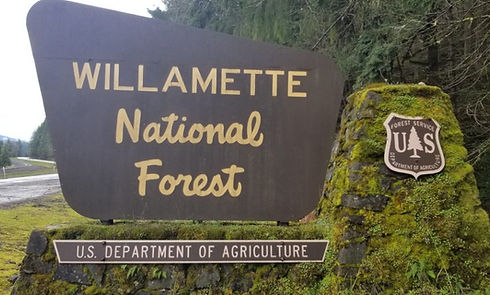Willamette National Forest

Planting in this forest.
The Willamette National Forest has a long history shaped by both natural and human-caused fires. Historically, fire has played an important role in maintaining the landscape, clearing dead and dry vegetation and promoting new growth. Indigenous peoples of the region also utilized fire for various purposes, such as enhancing foraging and hunting opportunities, maintaining vegetative balance, and managing the land.
While fire can be beneficial, the increasing frequency and severity of wildfires in recent years have raised concerns. Intense fires can lead to detrimental effects, including landslides on scorched land where vegetation that normally secures the soil has been lost. These landslides can result in increased sediment and pollutants entering waterways, which affect water quality. Additionally, severe wildfires can trigger ecosystem shifts, with non-native and invasive plant species taking root in burn scars far from mature trees, preventing natural forest regeneration.
In the past decade, the Willamette National Forest has experienced several major fires, including the catastrophic Beachie Creek, Holiday Farm, and Lionshead Fires in 2020. Together, these fires burned more than 540,000 acres, with 176,000 acres of that total located within the Willamette National Forest. In response to these destructive fires, forest managers have focused on restoring key areas within the burn perimeters.
From 2021 to 2023, over 980,000 trees were planted across 3,500 acres of the forest, and an additional 1.1 million trees are scheduled to be planted in 2024. The reforestation efforts span large areas, including riparian zones within the Santiam and McKenzie River watersheds, both of which are crucial for the local environment and the communities of western Oregon. These watersheds not only provide vital water resources for thousands of residents downstream but also offer numerous recreational opportunities. The visual and ecological benefits of reforestation are integral to the region’s long-term health.
The restoration project sites are also critical habitats for several wildlife species, including the federally listed spring Chinook salmon and the northern spotted owl, which is sensitive to habitat loss due to high-severity fires. While it may take decades for the replanted areas to fully transition into the mature forests favored by the northern spotted owl, these efforts provide the foundation for the species' future use of these lands. The owls can also utilize younger forests for certain behaviors, making the reforestation effort a positive step toward maintaining biodiversity.
The ongoing restoration of Willamette National Forest demonstrates the resilience of both the ecosystem and the people committed to preserving this vital landscape for future generations.




Location
Oregon, USA
Project Type
Reforestation
Environmental Benefits
Wildfire Restoration
Erosion Prevention
Habitat Restoration
Biodiversity Enhancement
Increased Carbon Capture
About this forest
Spreading across more than 1.6 million acres of western Oregon, Willamette National Forest runs along the Cascades and offers diverse views of mountain peaks, streams and waterfalls, old growth forests, and more. The National Forest lies only thirty minutes from Eugene and an hour and a half from Portland, two of Oregon’s largest cities.




